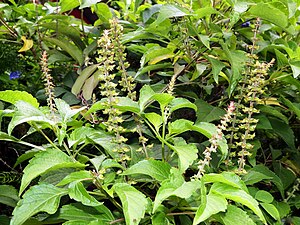Note: This is a project under development. The articles on this wiki are just being initiated and broadly incomplete. You can Help creating new pages.
Ocimum gratissimum
Ocimum gratissimum is an erect, much-branched, aromatic shrub. It can grow up to 50 - 300cm tall. The plant is often cultivated, mainly in the tropics, where it provides a range of culinary and medicinal applications and is an effective insect repellent.
Contents
- 1 Uses
- 2 Parts Used
- 3 Chemical Composition
- 4 Common names
- 5 Properties
- 6 Habit
- 7 Identification
- 8 List of Ayurvedic medicine in which the herb is used
- 9 Where to get the saplings
- 10 Mode of Propagation
- 11 How to plant/cultivate
- 12 Commonly seen growing in areas
- 13 Photo Gallery
- 14 References
- 15 External Links
Uses
Internal parasites, Fevers, Colds, Headaches, Impotence, Flatulence, Diarrhoea, Dysentery.[1]
Parts Used
Leaf, Seed, Root, Refined oil[2].
Chemical Composition
Common names
| Language | Common name |
|---|---|
| Kannada | Rama Tulasi |
| Hindi | Banjari |
| Malayalam | NA |
| Tamil | Elumichan Tulasi |
| Telugu | Nimma Tulasi |
| Marathi | NA |
| Gujarathi | NA |
| Punjabi | NA |
| Kashmiri | NA |
| Sanskrit | Arjaka, Rama Tulasi |
| English | Africal basil |
Properties
Reference: Dravya - Substance, Rasa - Taste, Guna - Qualities, Veerya - Potency, Vipaka - Post-digesion effect, Karma - Pharmacological activity, Prabhava - Therepeutics.
Dravya
Rasa
Guna
Veerya
Vipaka
Karma
Prabhava
Habit
Identification
Leaf
| Kind | Shape | Feature |
|---|---|---|
Flower
| Type | Size | Color and composition | Stamen | More information |
|---|---|---|---|---|
| Flowering from September to March | {{{5}}} |
Fruit
| Type | Size | Mass | Appearance | Seeds | More information |
|---|---|---|---|---|---|
| Fruiting from September to March |
Other features
List of Ayurvedic medicine in which the herb is used
Where to get the saplings
Mode of Propagation
How to plant/cultivate
Prefers a rich, light, well-drained to dry soil and a position in full sun.[5]
Commonly seen growing in areas
Along lake shores, In savannah vegetation, In submontane forest, Disturbed land.
Photo Gallery
References
External Links
- Ayurvedic Herbs known to be helpful to treat Internal parasites
- Ayurvedic Herbs known to be helpful to treat Fevers
- Ayurvedic Herbs known to be helpful to treat Colds
- Ayurvedic Herbs known to be helpful to treat Headaches
- Ayurvedic Herbs known to be helpful to treat Impotence
- Ayurvedic Herbs known to be helpful to treat Flatulence
- Ayurvedic Herbs known to be helpful to treat Diarrhoea
- Ayurvedic Herbs known to be helpful to treat Dysentery
- Herbs with Leaf used in medicine
- Herbs with Seed used in medicine
- Herbs with Root used in medicine
- Herbs with Refined oil used in medicine
- Herbs with common name in Kannada
- Herbs with common name in Hindi
- Herbs with common name in Tamil
- Herbs with common name in Telugu
- Herbs with common name in Sanskrit
- Herbs with common name in English
- Habit - Shrub
- Index of Plants which can be propagated by Seeds
- Index of Plants which can be propagated by Cuttings
- Herbs that are commonly seen in the region of Along lake shores
- Herbs that are commonly seen in the region of In savannah vegetation
- Herbs that are commonly seen in the region of In submontane forest
- Herbs that are commonly seen in the region of Disturbed land
- Herbs
- Pages without herbs images






